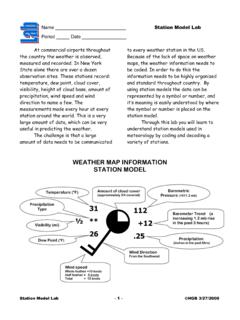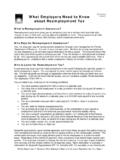Transcription of What You Absolutely Must Know to Pass the NYS …
1 You Absolutely Must know to Pass the NYSL iving Environment / Biology RegentsUNIT ONE: Science of the Living EnvironmentA. Terms:1. Observation: what is seen or Inference: A conclusion based on observation or Hypothesis: An untested prediction. A good hypothesis states both cause and effect ( If-then statement).4. Theory: A broad explanation of natural events that is supported by strong evidence. B. GraphingC. Controlled Experiment: Compares the results of an experiment between two (or more) groups. 1. Experimental group: Group being tested or receiving treatment.
2 (ex: new drug)2. Control group: Normal group. Should be identical to experimental group in every way except one: it does not receive the treatment ( : no drug, or given the original drug or a placebo).3. Placebo: A sugar pill or other fake treatment give to the control group so subjects do not know which group they are Independent Variable: Variable that is being tested (ex: new drug). In a graph the independent variable is always plotted on the X axis. 5. Dependent Variable: Variable that is measured at the end of an experiment; the results (ex: does patient get better?)
3 The dependent variable is always plotted on the Y Characteristics of a good Can be repeated by anyone and get the same Have large sample size/many test Are performed for longer periods of Test only one Are peer reviewed examined by several scientists to determine its Does not have to agree with the hypothesis. A scientist s guess is allowed to be incorrect and usually Is objective the experiment and conclusion are fair and unbiased. Fact and opinion are not TWO: Characteristics of Living ThingsA.
4 All living things must maintain homeostasis. 1. To maintain homeostasis, organisms carry out the same basic life functions: nutrition, excretion, transport, respiration, growth, synthesis, regulation and these terms!2. All life processes make up an organism s Failure to maintain homeostasis causes disease and Nutrition:1. Autotrophs make their own food, while heterotrophs eat other organisms. 2. Photosynthesis is carried out by plants, alga and blue-green bacteria (autotrophs). It takes the radiant energy of the sun and puts it in the bonds of sugar molecules.
5 Photosynthesis occurs mostly in the chloroplast of plant Plants have stomates, small holes in their leaves that let them exchange the gasses used in photosynthesis. Guard cells open and close the Respiration: Organisms get energy by breaking the bonds of sugar molecules. The released energy is used to make a molecule of ATP, which gives all organisms their Aerobic respirationrequires oxygen, and yields more ATP (energy) for a molecule of sugar than anaerobic (no oxygen) When humans are forced to get energy from anaerobic respiration, we produce lactic acid that damages muscles ( the burn you feel during exercise).
6 3. Photosynthesis and Aerobic Respiration are opposite reactions! They are also important in cycling oxygen, carbon, hydrogen and water through the Transport: Diffusion: movement of molecules from high concentrations to low concentrations. Requires no energy (passive transport).2. Active Transport requires the use of energy, usually moving molecules from a low concentration to a high concentration (against the flow of diffusion).3. Osmosis is the diffusion of water into or out of the cell. If water diffuses into the cell, the cell swells (get larger) and may burst.
7 If it loses water (being put in salt water for example) it will shrivel Regulation: coordination and control of other life A stimulus is a change in the environment that you respond A neuron is a nerve An impulse is the electrical signal carried by the nerves. Neurotransmitters are chemicals that help carry the A hormone is a chemical signal secreted by different glands in the body. Examples of hormones include insulin, adrenaline, testosterone and estrogen5. Receptor molecules are proteins on the surface of the cell membrane that receive signals from the nervous and endocrine system.
8 These are needed for your cells to communicate and work Chemistry 1. The most common elements in living things are (in order) Carbon, Hydrogen, Oxygen and Nitrogen (CHON).2. Organic Compoundshave Carbon AND Hydrogen (ex: C6H12O6 is organic, H2O, CO2, and NO3 are not). Organic molecules are also larger than inorganic Carbohydrates are sugars and starches. All carbohydrates are made from simple sugars (like glucose) and they supply Lipids store energy and include fats, oils and waxes. They are made from fatty acids and Proteins are made from amino acids.
9 Proteins also make hormones and many body and cell structures, so as far as your body is concerned, proteins are by far the most important of these three organic It is the SHAPE of proteins and how they fit together that determines what proteins can Four specific jobs of proteins: ) make enzymes2) make receptor molecules on the cell membrane. These are used to receive chemical messages (like hormones). 3) make antibodies4) make hormonesc. Enzymes are catalysts they affect the rates of chemical ) lock and key model one type of enzyme fits one type of molecule.
10 Change its shape and the enzyme will no longer ) very high temperaturescause proteins and enzymes to lose their shape so that they no longer work properly. This is why high fevers are pH: The pH scale measure the strengths of acids and bases. A low pH ( ) is a acid, a high pH ( ) is a base, and 7 is neutral (water).G. Cells- Cells are the basic unit of life. All living things (except viruses) are made of You must know the cell theory (all living things are made of cells).2. You must know the differences between plant and animal You must know the following organelles: cell membrane, cell wall, nucleus, chloroplast, cytoplasm, ribosome, vacuole, mitochondria4.









